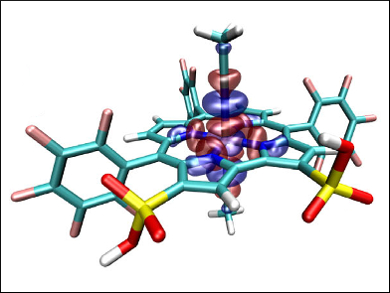Nitric oxide (NO) is an important cellular signaling molecule involved in many physiological and pathological processes, particularly blood vessel relaxation. The 1998 Nobel Prize in Physiology or Medicine was awarded for this discovery. Life-threatening conditions involving anomalous blood vessel contractions, like asthma or heart attacks, are typically indicated in advance by an increase in NO concentration in the exhaled air in the parts-per-million range.
It is thus highly relevant to routinely measure the NO concentration in exhaled breath, particularly for monitoring high-risk patients. Such monitoring requires a highly sensitive sensor. Martin Presselt, Friedrich Schiller University Jena, Germany, and colleagues have described an iron(III)–corrole complex that changes its transmission in the blue-to-violet spectral range in the presence of nitric oxide.
According to the researchers, the spectral changes are caused by charge-transfer transitions upon NO coordination. The pronounced effect allows the photometric detection of NO in air at concentrations down to 0.5 ppm. Since these corroles have been developed for incorporation in thin films, they are promising molecules for the development of micro-sized sensing devices for monitoring NO concentration in exhaled breath. This type of sensor could also monitor nitric oxide as an indicator for smog, as NO is also a byproduct of combustion in automobile engines and fossil fuel power plants.
- Photometric Detection of Nitric Oxide Using a Dissolved Iron(III) Corrole as a Sensitizer,
Stefan Fischer, Jenya Vestfrid, Atif Mahammed, Felix Herrmann-Westendorf, Martin Schulz, Jürgen Müller, Olaf Kiesewetter, Benjamin Dietzek, Zeev Gross, Martin Presselt,
ChemPlusChem 2016.
DOI: 10.1002/cplu.201500553



